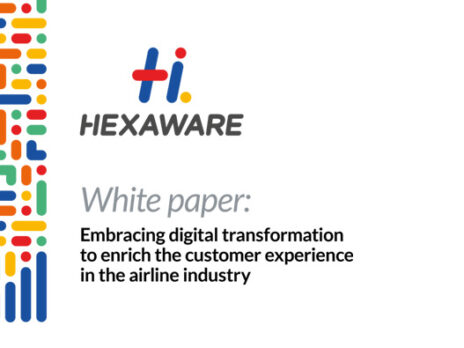
As the Covid-19 pandemic starts to ease, both leisure and business travel are expected to rebound strongly. In the already resurgent leisure market, it is millennial travellers who are leading the way, bringing with them a more tech-savvy approach to accessing goods and services. For the aviation industry, which is still bound to legacy systems and data silos, the customer experience expected from the smartphone generation may still be more than they can deliver.
Catering for the digitally empowered passenger is a key priority for airlines and airports, which must quickly embrace digital transformation to enrich customer experience. Key to that will be to harness artificial intelligence (AI), machine learning (ML) and the Internet of Things (IoT) to deliver the seamless, self-service, and automated experience that customers want.

“When we talk about digital transformation, customers want to use voice-based reservation, including integrating with Alexa or chatbots they have,” says Eswar Venkatachalam, global head of travel, transportation, logistics and hospitality at Hexaware. “More and more, travellers will be looking for that rather than going through the portal or the website or calling an agent.
“They are looking for self-service using their smartphones,” he adds. “From that standpoint, I believe that digital technology is going to play a major role. In addition, passengers demand more personalisation, so airlines and airports will be looking to use whatever data they have to bring more data intelligence and insight. Through that, they can create a ‘wow’ factor.”
Heeding the call for investment
Good customer service is increasingly dependent on technology, requiring the transformation of infrastructure and applications. Currently, many airlines rely on fragmented legacy systems and outdated processes, and keeping a vast volume of data in silos, all of which are hindering the development of strong customer relationships. To streamline their processes, scale up, and deliver a rich omnichannel experience, they need to develop a single source of truth about each passenger. This will require significant investment in emerging technologies, as well as the reorganisation of systems and processes improvements and optimisation
A key technology will be AI, which can facilitate on-demand customer support, enhance self-service opportunities, and increase operational efficiency by automating labour-intensive processes. AI chatbots or virtual travel agents can automate the booking process, while AI chatbots can facilitate reservation and passenger processing.
Then big data and IoT will help to build a “360° view” of those who travel. Together with ML, these can serve to streamline every stage of the journey, as well as creating opportunities for personalisation. For instance, harnessing multiple internal and external data sources, such as weather data, can enable predictive analytics to enable airlines and airports to proactively manage passenger services in the case of disruptions.
“The journey towards digital transformation and bringing more touchless, frictionless experience and more self-enablement began three or four years back,” says Eswar Venkatachalam. “Part of their legacy modernisation is passenger transformation, moving out of their legacy passenger services systems and now, with an anticipation that after Covid the market will pick up and the travellers will come back, they have started reinitiating some of the digital transformation programmes they halted.”
“Pretty much all the carriers are bouncing back, and they are doing well, and they are making investments,” he adds. “They are looking at it more from the point of view of attracting the passenger and how best they can increase their wallet share.”
That said, there is also a significant investment in driving cost out of the operating model. Technologies such as virtual reality (VR) and augmented reality (AR) are finding their way into crew training programmes, and AI and ML are helping to automate maintenance, repair, and operations (MRO) functions. Moving to cloud is also serving to reduce infrastructure cost.
“They began their digital transformation journey trying to improve the passenger experience, then they started looking at their internal enterprise systems to see how best the technology can support and empower their own workforce to do normal operations in a more remote way,” Eswar Venkatachalam says of operator intent. “They’re deeply looking at them improving their crew systems and also at how to bring more automation into HR and operations. So, they are focusing both on the passenger side and their own internal systems, particularly post-Covid.”
Lift off from legacy architecture
With investment required across the board, from passenger experience to internal management systems, digital transformation is a potentially strategic task for airlines and airports operating on thin margins and recovering from a two-year slump. Making every dollar of that investment count is a must.
“Airlines heavily invested into legacy technology in the past,” says Eswar Venkatachalam. “Almost all the airlines were looking only at the front end and keeping the legacy back end. Now, they are trying to modernise with the cloud and migrate core applications because aviation is a data-heavy industry. Moving all that data from on-premises legacy systems to the cloud is a huge investment.”
“Now, they want to see how best they can maximise the investment alongside all the other challenges going on with the industry, like fuel prices going up, operational cost going up” he adds “. So, they have to prioritise where they want to invest, how they want to invest and how best they can get ROI.”
That is where a partner like Hexaware – with its motto of “cloudify everything, automate everything and transform customer experience” – looks to deliver tangible value. Not only does the company have the right capability in terms of technology and processes, but it has also developed industry-specific expertise to ensure that the digital transformation process hits all the right pain points.
“Most of the carriers are trying to use their IT partners to maximise the partner’s strength and investments,” Eswar Venkatachalam explains. “At Hexaware, we can see the entire ecosystem, be it front-end or back-end systems, client-facing applications or commercial applications or enterprise applications Hexaware’s experience and expertise in technology and domain knowledge differentiate us.”
The next generation of travellers will demand newer technologies and more self-service capabilities, and it is important that airlines meet these needs while optimising their internal systems, given how competitive the market is. Digital transformation could deliver a sea change, but it may require an expert guiding hand.








